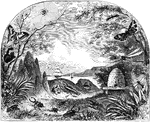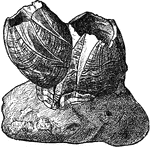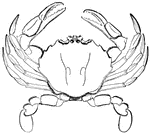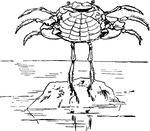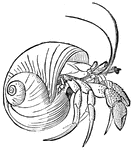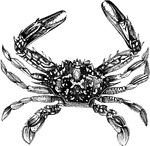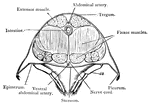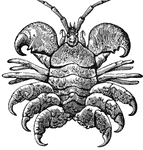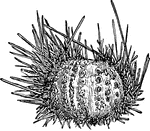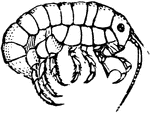
Amphipod
Amphipoda include over 7000 described species of small, shrimp-like crustaceans. Most amphipods are…
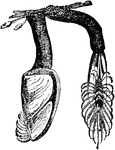
Barnacle
The Goose Barnacle has a body resembling a clam, attached by a soft, flexible stalk to some solid object.

Goose Necked Barnacle
A species of goose necked barnacles, a crustacean known for attaching itself to objects and other animals.
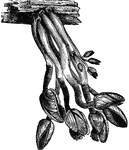
Barnacles
"The Common Barnacle, Lepas anatifera, perhaps the best-known example of the order, generally…

Calymene
"The trilobite's general form is shown in the annexed figure of the Calymene Blumenbachii;…

Ciliate
"Epistylis anastatica, magnified, growing in seven zoödendria or dendriform colonies of zoöids,…

Circulation of a Crustacean
Diagram of the circulation in a crustacean. Labels: a, branchial; b, somatic circulation. On the right…

Circulatory and Respiratory System of a Crayfish
Circulatory and respiratory system of the crayfish. C-heart with three pairs of ostia; Ps, pericardium;…
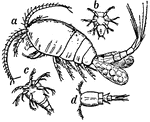
Copepoda
Copepoda, an order of Crustacea. A, cyclops quiadricornis; b, c, d, stages of growth in larvae.
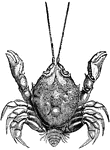
Corystes Cassivelaunus, female
"The anterior feet are about the length of the body. The other feet terminate in an elongated claw,…

Corystes Cassivelaunus, male
"The Long-clawed Crab is remarkable for its long antennae, which considerably exceed the length of the…

Crab
This illustration shows a crab, a species of cancer. Crabs are decapod crustaceans with thick exoskeletons.
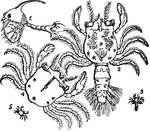
Crab
"Transformations of the Crab: 1, young crab, or zoea, magnified; 2, young crab, in a more advanced stage,…
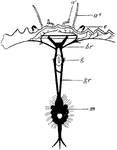
Shore Crab Nervous System
"Nervous system of shore-crab (Carcinus manas). br., The supra-oesophageal mass; g., gullet surrounded…

Shore Crab Zoaea
"Zoaea of common shore-crab (Carcinus manas). The appendages are numbered; c., gills; i., alimentary…
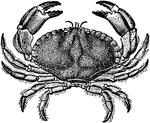
Dungeness Crab
The Dungeness crab is a species of crab that inhabits eelgrass beds and water bottoms from the Aleutian…

Edible Crab
The edible crab (Cancer pagurus) is a species of crab found in the North Sea, North Atlantic, and the…

Sand Fiddler Crab
The Sand Fiddler Crab (Uca pugilator) is a small crustacean in the Ocypodidae family of ghost and fiddler…
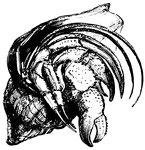
Hermit Crab
When alarmed, the hermit crab withdraws itself wholly into its portable house, closing the mouth of…
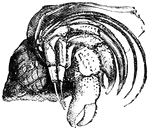
Hermit Crab
"When alarmed, the hermit crab withdraws itself wholly into its portable house, closing the mouth of…

Horseshoe Crab
Horseshoe crabs represent an order called Xiphosura, from the fact that the end of the abdomen is furnished…

Horseshoe Crab (Adult)
An illustration of an adult horseshoe crab from the dorsal aspect. The horseshoe crab or Atlantic horseshoe…
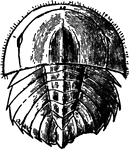
Horseshoe Crab (Young)
An illustration of a young horseshoe crab from the dorsal aspect. The horseshoe crab or Atlantic horseshoe…
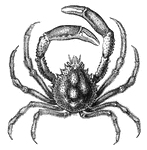
Spider-Crab
Crabs are ten-footed crustaceans. The abdomen is tucked out of site, so that nothing is visible except…

Crawfish
Crayfish, crawfish, or crawdads are freshwater crustaceans resembling small lobsters, to which they…
Crayfish
Longitudinal-section of a crayfish, showing digestive, circulatory, reproductive, excretory, and nervous…
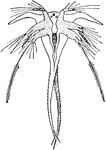
Barnacles
A barnacle is a type of arthropod belonging to infraclass Cirripedia in the subphylum Crustacean, and…

Barnacles
A barnacle is a type of arthropod belonging to infraclass Cirripedia in the subphylum Crustacean, and…
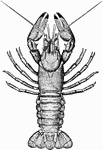
Crayfish
Crayfish, crawfish, or crawdads are freshwater crustaceans resembling small lobsters, to which they…

Crayfish
Crayfish, crawfish, or crawdads are freshwater crustaceans resembling small lobsters, to which they…

Cyclops
Cyclops, the representative of a number of lowly forms belonging to the order of Copepods, is one of…
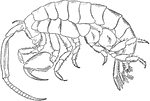
Marine Isopod
The marine isopod or sand flea (Gammarus) is in the sand, under rocks, and in the seaweed. Many are…

Marine Isopod
The marine isopod or sand flea (Caprella) is an omnivorous feeder that eats detritus, one-celled plants,…

Prawn
Prawns are crustaceans, belonging to the sub-order Dendrobranchiata. They are similar in appearance…

Scorpion
Scorpions are any arachnid of the order Scorpionida. Unlike the majority of arachnid species, scorpions…
Shrimp
The larger, more useful and more familiar Crustacea belong to the subclass Malacostraca. It comprises…

Cyclops
"The best-known form of the Copepoda is the genus Cyclops, specimens of whch may be found in…

Cypris
Cypris, a modern ostracod. Female before sexual maturity, right valve of shell removed to show internal…

Entresol
"A low story between two others of greater height, especially one so treated architecturally that from…
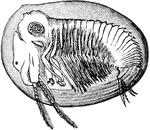
Estheria
Estheria californica is a species of Branchiopod crustaceans most closely resembling the shrimp.

Fiddler-crab
"The fiddler-crab has one large claw and one small one; the large claw is held in such a manner as to…

Water Flea
The Copepoda are represented by the cyclops, or water flea. This form is common in sluggish streams…
